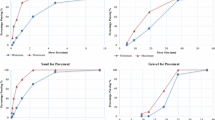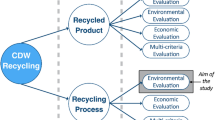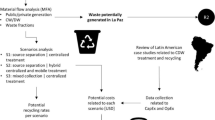Abstract
This study is performed to identify environmental aspects that can be improved during the derivation of recycled aggregates (RAs) from construction and demolition waste (CDW). The Life Cycle Inventory of RAs is established by considering the “gate to gate” scope. Primary data acquired by a Brazilian CDW processing company are used. The result shows that, to derive 1 m3 of RAs, the amount of raw material (i.e., CDW) required is 1.01 to 1.67 m3. The output includes embodied energy and water measuring 2.22–4.35 MJ/m3 and 15.38–30.30 L/m3, respectively; meanwhile, the CO2 emission from the beneficiation process is 5.07–6.20 kg·CO2/m3. Transport emissions are also significant in the environmental impact of recycled aggregates. CO2 emission associated with the transport of CDW and RAs is investigated, in which transport is optimized and non-optimized when the CO2 emission is 0.27–7.68 and 0.53–15.35 kgCO2/m3, respectively. This study is relevant to the circular economy and corroborates the closure of the life cycle of materials used in the civil construction sector by identifying the effects of CDW recycling and RA derivation, as well as their application in civil construction.








Similar content being viewed by others
Data Availability
The datasets generated during the current study are available from the corresponding author upon reasonable request.
References
Agopyan V, John VM (2011) The sustainability challenge in construction. Blucher, São Paulo, p 144. [in Portuguese]
ANEPAC, Associação Nacional das Entidades de Produtores de Agregados para Construção (2019) Prospects for the Aggregates Sector [in portuguese]
ABRELPE (2017) Panorama dos resíduos sólidos no Brasil - Edição Especial de 15 anos
De Schepper M, Van den Heede P, Van Driessche I, De Belie N (2014) Life cycle assessment of completely recyclable concrete. Materials 7:6010–6027. https://doi.org/10.3390/ma7086010
Adams KT, Osmani M, Thorpe T, Thornback J (2017) Circular economy in construction: current awareness, challenges and enablers. In: proceedings of institution of civil engineers: waste and resource management, ICE Publishing 15–24
Mi R, Pan G, Liew KM, Kuang T (2020) Utilizing recycled aggregate concrete in sustainable construction for a required compressive strength ratio. J Clean Prod 276:124249. https://doi.org/10.1016/j.jclepro.2020.124249
Rosado LP, Vitale P, Penteado CSG, Arena U (2019) Life cycle assessment of construction and demolition waste management in a large area of São Paulo State, Brazil. Waste Manage 85:477–489. https://doi.org/10.1016/j.wasman.2019.01.011
Wu H, Zuo J, Zillante G et al (2019) Status quo and future directions of construction and demolition waste research: a critical review. J Clean Prod 240:118163. https://doi.org/10.1016/j.jclepro.2019.118163
Hasan U, Whyte A, Al Jassmi H (2020) Life cycle assessment of roadworks in United Arab Emirates: recycled construction waste, reclaimed asphalt pavement, warm-mix asphalt and blast furnace slag use against traditional approach. J Clean Prod 257:120531. https://doi.org/10.1016/j.jclepro.2020.120531
Brasil (2017) Diagnóstico do Manejo de Resíduos Sólidos Urbanos. Brasília
EUROPEAN COMMISSION (2011) Service contract on management of construction and demolition waste - SR1
Calvo N, Varela-Candamio L, Novo-Corti I (2014) A dynamic model for construction and demolition (C&D) waste management in Spain: driving policies based on economic incentives and tax penalties. Sustainability 6:416–435. https://doi.org/10.3390/su6010416
Bravo M, De Brito J, Pontes J, Evangelista L (2015) Mechanical performance of concrete made with aggregates from construction and demolition waste recycling plants. J Clean Prod 99:59–74. https://doi.org/10.1016/j.jclepro.2015.03.012
Deloitte SA (2016) Resource Efficient Use of Mixed Wastes - Task 2 - Case Studies
Pickin J, Randell P, Trinh J, Grant B (2018) National Waste Report, Australia
Canada S (2016) Table 38–10–0032–01- Disposal of wast by source
United Nations (2019) The sustainable development goals report 2019
Pacheco-Torgal F, Jalali S (2010) Reusing ceramic wastes in concrete. Constr Build Mater 24:832–838. https://doi.org/10.1016/j.conbuildmat.2009.10.023
Cabeza LF, Rincón L, Vilariño V et al (2014) Life cycle assessment (LCA) and life cycle energy analysis (LCEA) of buildings and the building sector: a review. Renew Sustain Energy Rev 29:394–416
Atia NG, Bassily MA, Elamer AA (2020) Do life-cycle costing and assessment integration support decision-making towards sustainable development? J Clean Prod 267:122056. https://doi.org/10.1016/j.jclepro.2020.122056
John VM, Angulo SC (2003) Metodologia para desenvolvimento de reciclagem de resíduos. Porto Alegre
Sparrevik M, Utstøl S (2020) Assessing life cycle greenhouse gas emissions in the Norwegian defence sector for climate change mitigation. J Clean Prod 248:119196. https://doi.org/10.1016/j.jclepro.2019.119196
Zulcão R, Calmon JL, Rebello TA, Vieira DR (2020) Life cycle assessment of the ornamental stone processing waste use in cement-based building materials. Constr Build Mater 257:119523. https://doi.org/10.1016/j.conbuildmat.2020.119523
ANBT (2014) Associação Brasileira de Normas Técnicas - NBR ISO 14040: Gestão ambiental - Avaliação do ciclo de vida - Princípios e estrutura
ABNT (2009) Associação Brasileira de Normas Técnicas - NBR ISO 14044. Gestão Ambiental: Avaliação do Ciclo de Vida: Requisitos e Orientações. ABNT
John VM, Pacca SA, Angulo SC, et al (2011) Project for the Modular Life Cycle of Concrete Blocks and Floors
IBICT (2016) Guia Qualidata: requisitos de qualidade de conjuntos de dados para o Banco Nacional de Inventários do Ciclo de Vida. Brasília
Ye L, Qi C, Hong J, Ma X (2017) Life cycle assessment of polyvinyl chloride production and its recyclability in China. J Clean Prod 142:2965–2972. https://doi.org/10.1016/j.jclepro.2016.10.171
Aryan Y, Yadav P, Samadder SR (2019) Life cycle assessment of the existing and proposed plastic waste management options in India: a case study. J Clean Prod 211:1268–1283. https://doi.org/10.1016/j.jclepro.2018.11.236
Guinée JB, Heijungs R, Huppes G et al (2011) Life cycle assessment: Past, present, and future. Environ Sci Technol 45:90–96. https://doi.org/10.1021/es101316v
Buyle M, Braet J, Audenaert A (2013) Life cycle assessment in the construction sector: a review. Renew Sustain Energy Rev 26:379–388
Van Den Heede P, De Belie N (2012) Environmental impact and life cycle assessment (LCA) of traditional and “green” concretes: literature review and theoretical calculations. Cem Concr Compos 34:431–442. https://doi.org/10.1016/j.cemconcomp.2012.01.004
Patouillard L, Bulle C, Querleu C et al (2018) Critical review and practical recommendations to integrate the spatial dimension into life cycle assessment. J Clean Prod 177:398–412
Silva FB, Oliveira LA, Yoshida OS, John VM (2019) Variability of environmental impact of ready-mix concrete: a case study for Brazil. IOP Conf Ser Earth Environ Sci 323:012132. https://doi.org/10.1088/1755-1315/323/1/012132
BRASIL (2002) Resolução CONAMA no 307. Estabelece diretrizes, critérios e procedimentos para a gestão dos resíduos da construção civil. In: Conselho Nacional do Meio Ambiente
Empresa de Pesquisa Energética (Brasil) (2019) Balanço energético nacional: Ano base 2018. Rio de Janeiro
BRASIL (2011) 1° Inventário Nacional de emissões atmosféricas por veículos automotores rodoviários
CONVERTERLIVE (2022) Conversion of units of measure. https://convertlive.com/en/u/converter/quilowatts-hora/em/megajoules. Accessed 12 Dec 2022
Empresa de Pesquisa Energética (Brasil) (2021) Brazilian Energy Balance 2021 Year 2020. Rio de Janeiro
Dias A, Nezami S, Silvestre J et al (2022) Environmental and economic comparison of natural and recycled aggregates using LCA. Recycling. https://doi.org/10.3390/recycling7040043
Marinković S, Radonjanin V, Malešev M, Ignjatović I (2010) Comparative environmental assessment of natural and recycled aggregate concrete. Waste Manage 30:2255–2264. https://doi.org/10.1016/J.WASMAN.2010.04.012
Rosado LP, Vitale P, Penteado CSG, Arena U (2017) Life cycle assessment of natural and mixed recycled aggregate production in Brazil. J Clean Prod 151:634–642. https://doi.org/10.1016/J.JCLEPRO.2017.03.068
Acknowledgements
The authors would like to acknowledge the financial support from the National Council for Scientific and Technological Development (CNPq) for the current study (process 457309/2014-8), as well as UNILA/Pró-Reitoria de Pesquisa e Pós-graduação (PRPPG).
Author information
Authors and Affiliations
Contributions
CFP: conceptualization, methodology, data acquisition, results and discussion. Writing-original draft preparation. RB: data acquisition and analysis, Information regarding production process of aggregates. KRGP: conceptualization, methodology, production of data acquisition instrument, result analysis, writing-original draft preparation. EP: funding acquisition; conceptualization, supervision, methodology, results analysis, writing-reviewing and editing.
Corresponding author
Additional information
Publisher's Note
Springer Nature remains neutral with regard to jurisdictional claims in published maps and institutional affiliations.
Supplementary Information
Below is the link to the electronic supplementary material.
Rights and permissions
Springer Nature or its licensor (e.g. a society or other partner) holds exclusive rights to this article under a publishing agreement with the author(s) or other rightsholder(s); author self-archiving of the accepted manuscript version of this article is solely governed by the terms of such publishing agreement and applicable law.
About this article
Cite this article
Paz, C.F., Biela, R., Punhagui, K.R.G. et al. Life cycle inventory of recycled aggregates derived from construction and demolition waste. J Mater Cycles Waste Manag 25, 1082–1095 (2023). https://doi.org/10.1007/s10163-023-01594-y
Received:
Accepted:
Published:
Issue Date:
DOI: https://doi.org/10.1007/s10163-023-01594-y




